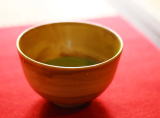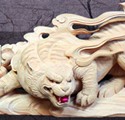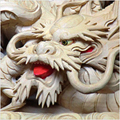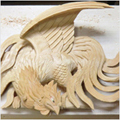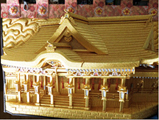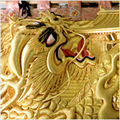photo by Ehime Prefectural Government HP, Ehime good products picture book |
SAIJOU DANJIRI CHOUKOKU |
| (Ehime) / sculpture |
| The Saijou Festival is held in Saijou city, Ehime Prefecture every year
during October. It is known as the Festival that dedicates shrines to DANJIRI
featuring a Float, and Drums. It is characterized by fine carvings that
even detail bird feathers. The placement of shadowing is determined by
the thickness and type of panel. |
| |
photo by Ehime Prefectural Government HP, Ehime good products picture book |
TAIKODAI SHISYUU KAZARIMAKU |
| (Ehime) / embroidered curtain |
| There is the famous Festival "NIIHAMA TAIKO MATSURI (The Festival
of Drums in NIIHAMA)" held in Shikoku , Japan. It is so gallant, and
beautiful. The origin is said to date back to the Kamakura or Heian Period.
Drum stands are decorated with an original embroidered curtain. It’s known
as TAIKODAI SHISYUU KAZARIMAKU and is a three-dimensional embroidered art
form, handmade and unique, employing an ancient and highly skilled technique. |
| |
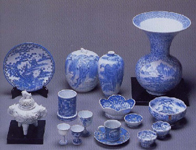
photo by Nagasaki Prefectural Government HP, Nagasaki Traditional Craft
Page and Toukei kids |
MIKAWACHI YAKI |
| (Nagasaki) / vase, ornamental panel, vase, kitchen ware |
| The origin of MIKAWACHIYAKI dates back near the end of the 16th century. It was characterized by a coating of cobalt over white porcelain. It was used together with articles for presentation to the Shogun and to the Court. Even today, there is a lot of pride in the unique design and technique of KARAKOE. Cooking utensils are the main products. Incense burners and vases are also produced. This craft was designated as a Traditional Craft by Japanese Government in 1978. |
| |
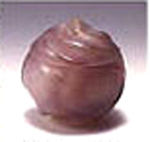
photo by Kansai Bureau of Economy,Trade and Industry HP,Traditional Crafts
information page |
WAKASA MENOU ZAIKU |
| (Fukui) /jewelry, incense burner, ornamental craft |
| The Menou-zaiku technique was developed by Kihei Tanaka during the Edo
Period. Ornamental carving was added by Kiyosuke Nagawa during the Meiji
Period. The process requires high quality skill and patience. It was designated
a Traditional Craft by the Japanese Government in 1976. |
| |
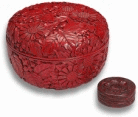
photo by Kanagawa Prefectural Government |
KAMAKURA BORI |
| (Kanagawa)/vessel, tray, dish, tea set |
| Kamakura carving was born in the 14th century by the infuence of lacquer
carving products that were first introduced from China. The charm of Kamakura
carving are movement and strong sculpture, lacquer with the moisture. In
addition, it have made with natural materials and traditional skills. So
it's extremely robust. It was designated as a Traditional Craft by Japanese
Government in 1979. |
| |

copyright |
NANBU DANSU |
| (Iwate) / chest, table |
| NANBU DANSU is made out of paulownia and zelkova wood that grows in Iwate.
It has a beautiful wood grain. The smooth lacquer finish and metal engraving
is done by hand and results in a magnificently elegant Dansu. |
| |

copyright |
 SENDAI TANSU SENDAI TANSU |
| (Miyagi)/chest |
| SENDAI TANSU is made of chestnut zelkova (cedar and paulownia heart wood).
It’s carefully finished in lacquer with a number of gorgeous metal ornaments
attached. There are plenty of iron fittings on the front side. Each process
used to produce this Tansu requires a highly technical expertise. The art
of producing such Tansu has been designated a Miyagi specified technical
craft. |
| |

copyright |
 TAMAMUSHI NURI TAMAMUSHI NURI |
| (Miyagi) / vase, box, decorated dish |
| It is not understood how the distinctive silver powder paint is applied
that renders a deep gloss on the inside of the vessel. Also iridescent
colors similar to those of the Tamamushi (Jewel Beetle), an insect with
an iridescent wing sheath, are not found on previous types of lacquer ware.
It's really a unique art form and it has been designated a Miyagi specified
technical craft. |
| |

copyright |
SAKATA FUNADANSU |
| (Yamagata) / portable chest |
| FUNADANSU is a small chest that can be carried onboard a ship. There are
both KAKESUZURI and TYOUBAKO that contained cash and important documents,
HANGAI are costumes stored within the chest. The internal structure of
the chest is made so it’s difficult for water to penetrate in the event
the chest should be accidentally dropped into the sea. |
| |

copyright |
 KOUSYUU SUISYOU KISEKI ZAIKU KOUSYUU SUISYOU KISEKI ZAIKU |
| (Yamanashi) / ornamental craft |
| Materials used are natural stone crystal or jade. They were originally crafted about 1,000 years ago as artistic ornaments. This art form was considered a Traditional Craft by the Japanese Government in 1976 and was designated as a Yamanashi specified technical craft in 1994. |
| |

copyright |
OWARI SHIPPOU |
| (Aichi) / vase, ornamental craft, jewelry box |
| It is said that Tsunekichi Kaji, from Owari, devised the process during
the Tenpou years of the Edo Period. A metal matrix of silver or copper
was used. YUUSEN SHIPPOU, a method whereby a silver line was drawn on a
piece to outline of the design, is a typical OWARI SHIPPOU. Technique.
It was designated as a Traditional Craft by the Japanese Government in
1995. |
| |

copyright |
ICHI ITTOUBORI |
| (Gifu) / ornamental sculpture |
| A carving done in ICHI wood that grows in the Hida mountains, is a unique
form of naturally colored sculpture. It was designated as a Traditional
Craft by the Japanese Government in 1975. |
| |

copyright |
TAKAOKA DOUKI |
| (Toyama) / flower vase relief, incense burner |
| Originating during the beginning of the Edo Period, it was developed by emplying a casting technique known as Karakane. The process was designated as a Traditional Craft by the Japanese Government in 1975. |
| |

copyright |
TAKAOKA SHIKKI |
| (Toyama) / chest ornamental craft |
| This process was characterized by various techniques that produced a three-dimensional
impression by using a variety of colored lacquers that can be seen in TYOUKOKUNURI,
SABIE, RADEN and ZONSEI. These techniques were used to produce Gorgeous
MIKURUMA in a festival that displayed Takaoka. The process was designated
as a Traditional Craft by the Japanese Government in 1975. |
| |

copyright |
KUTANI YAKI |
| (Ishikawa) / flower vase, ornamental craft, tea set |
| Kutani Yaki made its debut in the middle of the 17th century. The style
of KOKUTANI (old Kutani) combined beauty and authority. It was designated
as a Traditional Craft by the Japanese Government in 1975. |
| |

copyright |
NISHIJIN ORI |
| (Kyoto) / Nou costume, obi, kimono, wedding kimono, textiles, bag |
| This is a high-quality silk textile produced in Kyoto. The production method
makes use of a number and variety of skills that produce just a limited
quantity. There are more than twenty processes necessary to complete Nishijin.
Each step is a division of labor conducted by expert artisans. This hand-woven
technique produces a textile of gorgeous and refined opulence. It was designated
a Traditional Craft by the Japanese Government in 1976. |
| |

copyright |
KYOU NUI |
| (Kyoto) / kimono, obi, Noh costumes, ornamental goods |
| History of embroidery in Japan began during the Asuka Period. Embroidery
was first expressed in Buddhism. In the beginning it was used for adorning
clothes during the Heian Period. It is a technique that utilizes gold,
silver and other colored silk. It is characterized by a brilliant and luxurious
finish. It was designated as a Traditional Craft by the Japanese Government
in 1976. |
| |
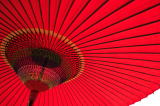 D.D.Revolution
D.D.Revolution